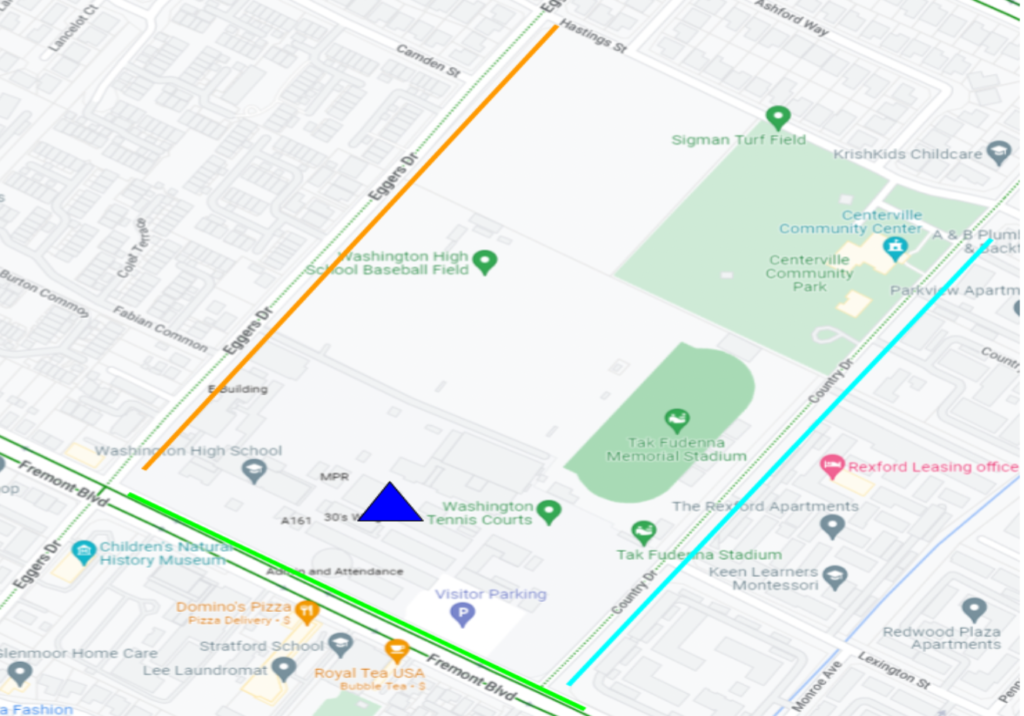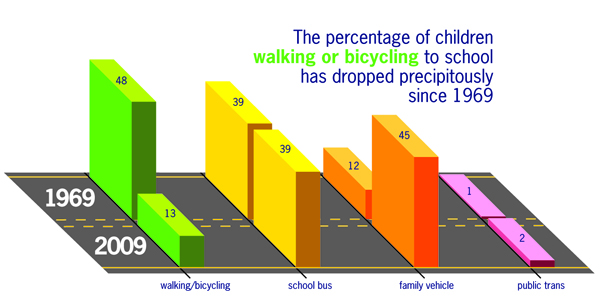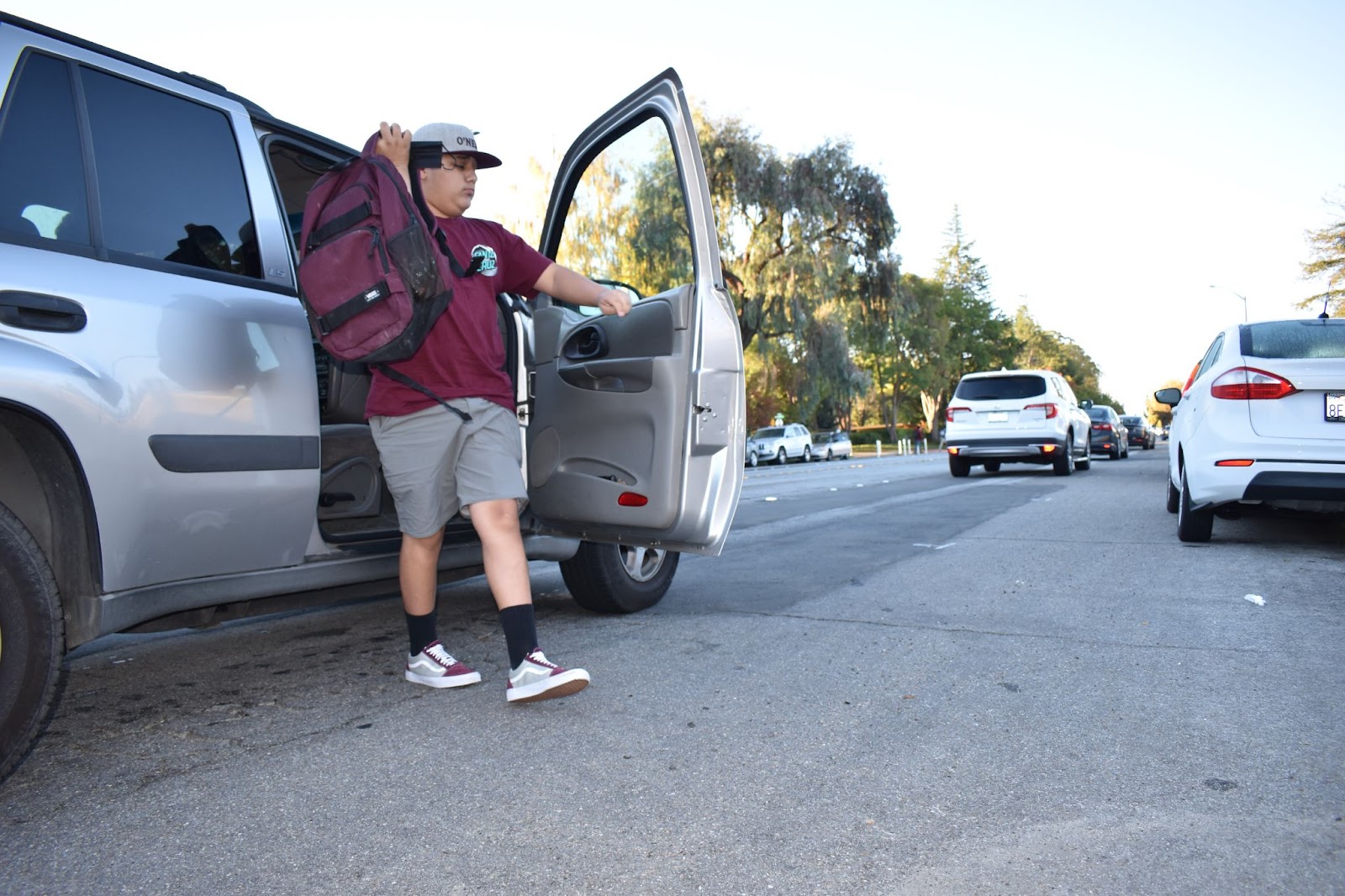Images provided by author and Safe Routes Partnership.
Recently, Fremont has increasingly focused on the safety of our pedestrians and cyclists. This past year, a sweeping change has come to this suburban city in the form of bike infrastructure, such as elevated bike lanes on Walnut Blvd, dozens of new and improved intersections adjusted for pedestrians, and a two-way bike lane at American High School. But, it seems we have forgotten about the central hub for many cyclists in Fremont: our high school. The problems which are given great attention in other parts of the city seem to get ignored at our school.

What are these issues? To understand them, we must understand the points of conflict within the block that surrounds the school (which is marked with a dark blue triangle). There are three roads that surround the school: Fremont Boulevard (green), Eggers Drive (orange), and Country Drive (light blue). Because of the size of Fremont Blvd, there is no student drop-off, though the issue of jaywalking has been looked at and addressed by the school. The roads with more conflict are Eggers Dr and Country Dr. These roads are not big enough to keep people from getting out like Fremont Blvd, but too small to be easy to control. Looking specifically at Eggers, it is only two lanes, one each way. Accompanied is a lane of streetside parking going northwest from Fremont towards Paseo Padre. This leaves just a couple of feet for bikes between the cars driving on their left, and the cars parked on their right. Parking is not that useful along Eggers Dr: there is only space for about 30 cars along the whole road, and because the space is quite small, most larger cars like trucks have little to no space to park, especially if they are forced to parallel park in a tight space. During the early morning and after-school rush, both lanes are full, leaving the entire road blocked if one tries to turn around or parallel park. A similar situation occurs on Country. Luckily, it is a much wider road, having two lanes each way, with a streetside parking lane going each way. However, the same issue arises as on Eggers: there is no infrastructure for cyclists because of streetside parking, leaving cyclists with just the space between parked cars and cars in the rightmost lane.
What issues are created for cyclists on these roads? On Country Dr, there is no safety for a cyclist because the cars are going towards the school heading southwest, and there is no space on the right side for bikes. In any other situation, this would just leave bikes in an uncomfortable situation. However, being a school, unique issues arise. Especially in the last minutes of the morning before school starts, students are in a rush, as being just seconds late to class can result in detention after school. Even more unfortunately for cyclists and late students, there is consistent congestion at the intersection of Country Dr and Lexington St, due to an unavoidable stop sign right before the turn into the parking lot where it is safe to drop students off. This leaves students in a rush, waiting, and unmoving. They open the door into the street and run out of the car. But who is in that space, right next to the car, to the right? Cyclists! This occurrence is possible at any moment, as the passengers cannot see the rear view in the mirror right beside them. If the cyclist is there at the wrong moment, getting a door opened into your side will surely result in hefty injury. This forces many cyclists to take the sidewalk, putting themselves in danger and interfering with pedestrians, or not biking at all, further leading to saturation of those streets, making a drive to school that should take just 10 minutes in the morning, last upwards of 20 minutes if one does not leave early enough.

How come this doesn’t happen on Eggers Dr? On Country Dr, the whole street has parking, until the intersection with Lexington St. On Eggers Dr, it is the other way around. Before cyclists get to the school, there is no parking; only afterwards can cars park. Additionally, there is infrastructure to reduce the speed of cars, leading them to be stopped less. Fundamentally, this is the difference in safety. Giving cyclists their own space for riding on the road, at the very least until they can get to school, allows them to not be at the mercy of people randomly getting out of their cars.
What are the solutions for solving this issue? The Bike Master Plan for Fremont, which is revised every 5 years, calls for road dieting, the practice of removing lanes of traffic to replace with bike infrastructure, through the addition of a parking protected bike lane. This will leave one lane for Country, each way, retain parking, and allow for cyclists to be able to ride in a protected bike lane. However, this change is only expected to come in the next couple of years, when the road gets repaved. What options are there in the short term? Can we use the school’s ability to give detentions as a way to deter students from dangerously rushing to school?
A core part of the cause of biking being so neglected is that very few people bike to school. Schools have been made for busses, and as more and more people own cars, cycling has lost its purpose to students. We should start by making the roads around school safer for our students, and to match the progress the city of Fremont has made with road safety for cyclists. Beyond that, Washington High School lags behind other schools in outreach to make biking incentivized for students. As long as very few people bike to school, cyclists will likely never get a safe ride to school.
Venya Karpelevitch is a junior at Washington High School. He has lived and grown up in Fremont, California. This is his first year at The Hatchet. His journalistic interests are politics and Jewish issues. His hobbies include video games, biking, and debate. He plans on pursuing chemistry in college, as well as learning at a yeshiva.

